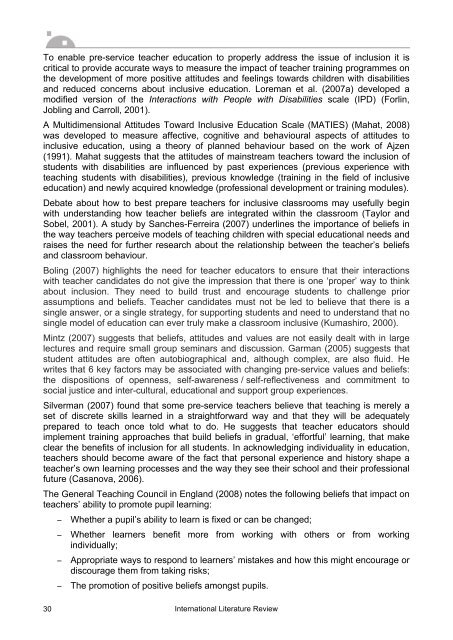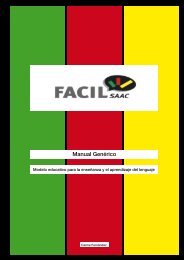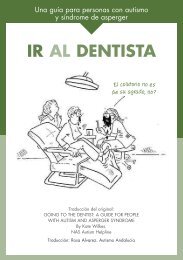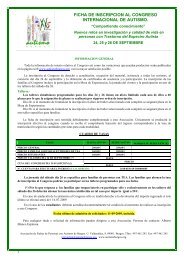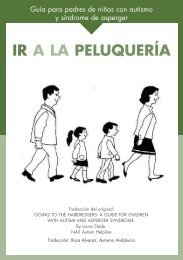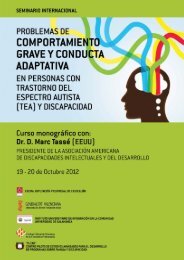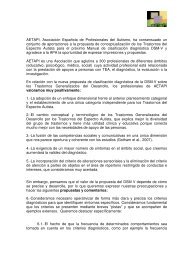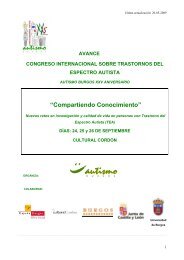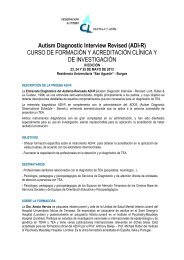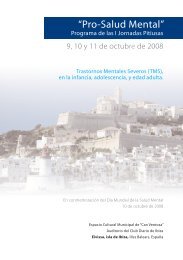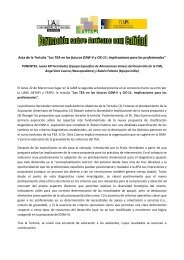TEACHER EDUCATION FOR INCLUSION - Aetapi
TEACHER EDUCATION FOR INCLUSION - Aetapi
TEACHER EDUCATION FOR INCLUSION - Aetapi
Create successful ePaper yourself
Turn your PDF publications into a flip-book with our unique Google optimized e-Paper software.
To enable pre-service teacher education to properly address the issue of inclusion it is<br />
critical to provide accurate ways to measure the impact of teacher training programmes on<br />
the development of more positive attitudes and feelings towards children with disabilities<br />
and reduced concerns about inclusive education. Loreman et al. (2007a) developed a<br />
modified version of the Interactions with People with Disabilities scale (IPD) (Forlin,<br />
Jobling and Carroll, 2001).<br />
A Multidimensional Attitudes Toward Inclusive Education Scale (MATIES) (Mahat, 2008)<br />
was developed to measure affective, cognitive and behavioural aspects of attitudes to<br />
inclusive education, using a theory of planned behaviour based on the work of Ajzen<br />
(1991). Mahat suggests that the attitudes of mainstream teachers toward the inclusion of<br />
students with disabilities are influenced by past experiences (previous experience with<br />
teaching students with disabilities), previous knowledge (training in the field of inclusive<br />
education) and newly acquired knowledge (professional development or training modules).<br />
Debate about how to best prepare teachers for inclusive classrooms may usefully begin<br />
with understanding how teacher beliefs are integrated within the classroom (Taylor and<br />
Sobel, 2001). A study by Sanches-Ferreira (2007) underlines the importance of beliefs in<br />
the way teachers perceive models of teaching children with special educational needs and<br />
raises the need for further research about the relationship between the teacher’s beliefs<br />
and classroom behaviour.<br />
Boling (2007) highlights the need for teacher educators to ensure that their interactions<br />
with teacher candidates do not give the impression that there is one ‘proper’ way to think<br />
about inclusion. They need to build trust and encourage students to challenge prior<br />
assumptions and beliefs. Teacher candidates must not be led to believe that there is a<br />
single answer, or a single strategy, for supporting students and need to understand that no<br />
single model of education can ever truly make a classroom inclusive (Kumashiro, 2000).<br />
Mintz (2007) suggests that beliefs, attitudes and values are not easily dealt with in large<br />
lectures and require small group seminars and discussion. Garman (2005) suggests that<br />
student attitudes are often autobiographical and, although complex, are also fluid. He<br />
writes that 6 key factors may be associated with changing pre-service values and beliefs:<br />
the dispositions of openness, self-awareness / self-reflectiveness and commitment to<br />
social justice and inter-cultural, educational and support group experiences.<br />
Silverman (2007) found that some pre-service teachers believe that teaching is merely a<br />
set of discrete skills learned in a straightforward way and that they will be adequately<br />
prepared to teach once told what to do. He suggests that teacher educators should<br />
implement training approaches that build beliefs in gradual, ‘effortful’ learning, that make<br />
clear the benefits of inclusion for all students. In acknowledging individuality in education,<br />
teachers should become aware of the fact that personal experience and history shape a<br />
teacher’s own learning processes and the way they see their school and their professional<br />
future (Casanova, 2006).<br />
The General Teaching Council in England (2008) notes the following beliefs that impact on<br />
teachers’ ability to promote pupil learning:<br />
30<br />
− Whether a pupil’s ability to learn is fixed or can be changed;<br />
− Whether learners benefit more from working with others or from working<br />
individually;<br />
− Appropriate ways to respond to learners’ mistakes and how this might encourage or<br />
discourage them from taking risks;<br />
− The promotion of positive beliefs amongst pupils.<br />
International Literature Review


